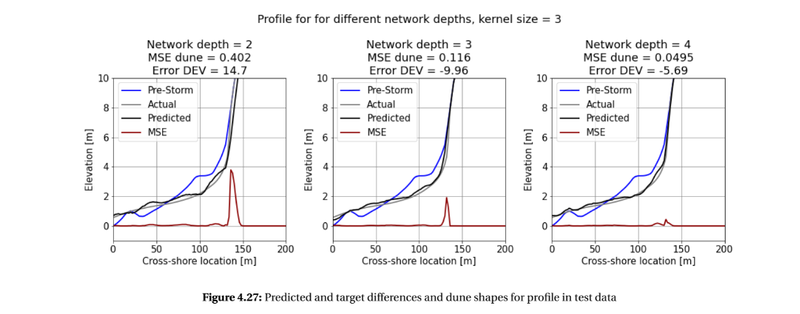K. van Asselt1, J.A.A. Antolinez2, P. Athanasiou1, A.J.H.M. Reniers2, R. McCall1, A. Heinlein3
1Deltares, Netherlands 2 TU Delft, Netherlands
koen.vanasselt@deltares.nl
Introduction
Sandy coasts cover about 30% of the world’s coastline and offer several economic and ecological services. Dunes are a typical feature of sandy coasts and offer natural protection from the sea. In extreme storm conditions, the impact of the sea on these dunes results in sediment transport in seaward direction. To be able to guarantee the protection service of dunes and prevent the hinterland from flooding, models are developed to predict sediment transport processes at the dune (dune erosion).
Surrogate models, model of a model, have been developed to reduce computational times of dune erosion calculation. The state of art surrogate models provide a prediction based on a parameterized input and output (Athanasiou et al., 2022 and Gharagozlou et al., 2022). However, a desired surrogate model is able to dealwith spatial input and the prediction of the actual shape of the post-storm sandy profiles.
Objective and Methods
Initially, dune erosion processes and existing surrogate modelling techniques are explored. Through studying
theory on neural networks, U-Net, a CNN architecture developed for image segmentation, is chosen as a suitable convolutional neural network to process 1D pre-storm input profiles and predict 1D post-storm profiles. The potential of using the U-Net architecture is explored with a simplified dataset with known morphological dune response, stationary storm conditions and several performance metric. Through this exploration, the goal is to replicate these dune erosion processes using a surrogate model. The gained insights are used to scale up to a more realistic scenario for the Holland coast.
Parameter sensitivity analyses on the DEV showed that, in general, steeper slopes of submerged profile sections lead to an increase in DEV. Especially the beach- and nearshore slope have a large effect on the modelledDEV
Results
It was found that the network depth, network width and kernel size are crucial hyperparameters for the interpretation of the data by U-Net and the performance of the surrogate model A shallow U-Net architecture is not able to gain an understanding of the processes of dune erosion and attempts to find the statistically optimal solution. In contrast, a deeper and more complex U-Net enables the surrogate model the mimic dune erosion processes and catches a wider range of dune erosion volumes (DEVs). However, it is important to note that due to the lack of alongshore variability in the test data, the improvements resulting from a deeper architecture may not be fully reflected in the performance indicator. In the upscaling phase, the results on a realistic training and test dataset confirm the trends found in the exploration phase of this research. A multi-profile-based training dataset outperforms a single-profile-based
training dataset. Accuracy and skill in post-storm profile shape prediction are obtained through either deeper networks or larger kernel sizes. However, it was found that the current surrogate model has trouble overcoming spatial alterations at the location of erosion processes. .

Predicted and target differences and dune shapes for profile in test data










